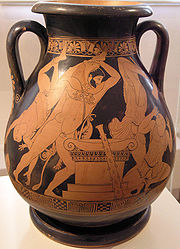
Mannerists (Greek vase painting)
Encyclopedia

Attica
Attica is a historical region of Greece, containing Athens, the current capital of Greece. The historical region is centered on the Attic peninsula, which projects into the Aegean Sea...
red-figure vase painters, stylistically linked by their affected painting style.
The group comprised more than 15 artists. They preferred to paint column kraters, hydria
Hydria
A hydria is a type of Greek pottery used for carrying water. The hydria has three handles. Two horizontal handles on either side of the body of the pot were used for lifting and carrying the pot. The third handle, a vertical one, located in the center of the other two handles, was used when...
i and pelike
Pelike
A pelike is a one-piece ceramic container similar to an amphora.It has two open handles that are vertical on their lateral aspects and even at the side with the edge of the belly, a narrow neck, a flanged mouth, and a sagging, almost spherical belly....
s. They were active from about 480 BC until near the end of the 5th century BC. Their main characteristic is that they maintained features of black-figure vase painting, which had been nearly completely replaced by the red-figure style. Their figures seem elongated and have small heads, the garment folds are falling stiff, resembling stairs, and the images are framed with black-figure style ornamentations. The range of motifs is also influenced by previous periods. Thus, Achilles
Achilles
In Greek mythology, Achilles was a Greek hero of the Trojan War, the central character and the greatest warrior of Homer's Iliad.Plato named Achilles the handsomest of the heroes assembled against Troy....
and Ajax
Ajax (mythology)
Ajax or Aias was a mythological Greek hero, the son of Telamon and Periboea and king of Salamis. He plays an important role in Homer's Iliad and in the Epic Cycle, a series of epic poems about the Trojan War. To distinguish him from Ajax, son of Oileus , he is called "Telamonian Ajax," "Greater...
playing a boardgame, a popular black-figure motif introduced by Exekias
Exekias
Exekias was an ancient Greek vase-painter and potter, who worked between approximately 550 BC - 525 BC at Athens. Most of his vases, however, were exported to other regions of the Mediterranean, such as Etruria, while some of his other works remained in Athens. Exekias worked mainly with a...
, are depicted often. The figures gesticulate as if using a form of sign language, especially the hands often appear stiff and theatrical. Komos
Komos
The Komos was a ritualistic drunken procession performed by revelers in ancient Greece, whose participants were known as komasts. Its precise nature has been difficult to reconstruct from the diverse literary sources and evidence derived from vase painting....
and symposion scenes are especially popular. Influenced by other contemporary painters, the second generation of mannerists favoured domestic scenes. Occasionally, they also depicted rare motifs, such as the madness of Salmoneus
Salmoneus
In Greek mythology, Salmoneus was the son of Aeolus and Enarete, the brother of Athamas, Sisyphus, Cretheus, Perieres, Deionus, Canace, Alcyone, and Perimede. Salmoneus was the father of Tyro by his first wife Alcidice, the second one being Sidero....
, of which they produced the only known painting.
The earliest representatives of the style worked in the workshop of the potter Myson between 480 and 450 BC. The most important artist of the style at that time was the Pan Painter
Pan Painter
The Pan Painter was an ancient Greek vase-painter of the Attic red-figure style, active ca. 480 to 450 BC. A pupil of Myson, he stands the beginning of the Mannerists, though his drawing technique is considered the finest. Sir John Beazley attributed over 150 vases to his hand...
. Also significant were the Pig Painter, the Leningrad Painter and the Agrigento Painter. The middle phase, between about 450 and 425 BC, is dominated by the Nausikaa-Hephaistos Group, comprising seven artists. Its leading and eponymous artists were the Nausikaa Painter and the Hephaistos Painter. The last important artists of the style, near the end of the 5th century, are the Academy Painter and the Painter of Athens 1183.

